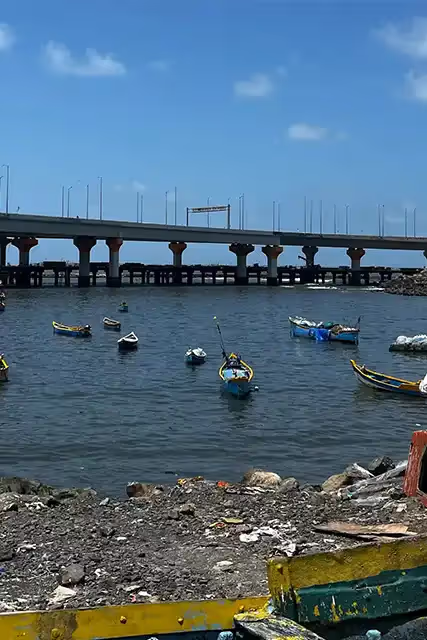Shrinking fish populations spark environmental fears






You could once taste the salt of Mumbai’s Arabian Sea in the air while driving along the coast. Now, instead of that familiar breeze, you see barricades and bulldozers everywhere. It all started in 2011 when a politician brought back an idea from the 1960s, originally suggested by American consultants: building a road in the sea along Mumbai’s coast.
Despite regulations introduced in 1991 to prohibit new reclamation projects, the government amended the rules and greenlighted the project. The INR 13,000 crore project is seen by many as a way to ease travel across the city, but not everyone shares this enthusiasm.

On a hot September afternoon at Lotus Jetty, which overlooks the Haji Ali Dargah, fishermen stand by, watching their boats float in a barely existent harbour. Wajid Mohammad, one of the fishermen, is busy untangling his net on a boat that now returns mostly empty. “A boat full of fish is a rare sight now,” he said. Over the past few months, the reclamation work for the Coastal Road project has upended the lives of these fishermen, leaving them anxious about what lies ahead.

We’ve known the sea since childhood. Haji Ali was our only home.
“We have suffered major losses since construction began,” said Wajid. In 2022, they could still find some species like crabs, but now those too have disappeared. Fishermen like Wajid are left with no choice but to seek work elsewhere. “We’ve known the sea since childhood. Haji Ali was our only home,” he added.
The disappearing fish
Hasan Wali Muhammad, a young fisherman, lists the fish that have disappeared because of the new infrastructure. "Lobster, tiger prawn, khajura (barramundi), hekru (grouper), rawas (Indian salmon) – none of them are found here anymore," he said. Pointing to the concrete shoreline, he added, "The fish used to be this close. We never had to go far, but now we do." The fisherfolk mentioned that while the recent Shravan month saw lower demand for their produce, things will only worsen once the demand picks up.
Environmental impact
Coastal construction is a risk anywhere, as it disrupts natural habitats, but in a city like Mumbai, where heavy rainfall and floods are common, the risk may be even greater. “The currents have worsened, which is why our nets get tangled,” said Bilaal, another fisherman, as Wajid continues to untangle his nets, now filled with trash.

The real issue is that the fishing and docking areas have disappeared. When a habitat vanishes, it impacts the entire coastline.
“The kachra [debris] is negligible in that entire Great Pacific patch,” said Pratip Patade, a Mumbai native who has spent years documenting the city’s biodiversity and the threats to its shores. “The real issue is that the fishing and docking areas have disappeared. When a habitat vanishes, it impacts the entire coastline.”

Changing habitats
Patade, who is also the director of the Coastal Conservation Foundation, a non-profit organisation focused on marine wildlife awareness, has seen first-hand how the reclamation has altered Mumbai’s coastline. “The whole habitat has changed. The reclaimed area is 200 metres. So, the area was exposed and the animals in the upper zone vanished,” he added.
He also noted that it’s not just Lotus Jetty; other parts of Mumbai have faced the same issue. “Choti chowpatty, Carter Road, Tata gardens have all been reclaimed,” he said.
Despite the project's widespread opposition from urban planners, environmentalists, and fishermen, the construction continued unabated.
“So many gaps exist in this project,” said Patade. “Firstly, there was a lack of research specific to Mumbai’s coastline. After 1970, nobody studied it, so when they did the Environmental Impact Assessment (EIA), they suggested mitigation measures, but no one checked if they were implemented.”
The Sixth Assessment Report of the Intergovernmental Panel on Climate Change (IPCC) in 2022 highlighted that the Indian Ocean has experienced the fastest rise in sea temperatures globally since the 1950s. Experts warn that the lack of research on how infrastructure interacts with rising sea levels is slowly creating conditions for natural disasters, both now and in the near future.
Legal troubles
While the Coastal Road is now functional, its legal status remains murky, “The Coastal Road is still technically illegal. When the Conservation Action Trust took the case to court, the High Court referred it to the Supreme Court, which issued a stay. But during the pandemic, they continued building, so the road is up and running, but the court case is still pending,” said Patade.

The municipality promised to compensate them for the losses they incurred due to the construction. However, no payments have been made since work began in 2017. “Boat owners were promised compensation of Rs 13-15 lakh, and we were supposed to receive Rs 2.5-5 lakh, but nothing has been finalised,” said Wajid.
Court cases, researchers, and NGOs are all helpless now.
Hasan said the BMC has made it clear they won’t address the situation. "They plan to remove the remaining silt to build a wall to support the project. We’re already forced to keep our belongings on the rocks because there's no space. After Ganesh Chaturthi [late September], they’ll ask us to leave this area too," he added.
The fisherfolk of Haji Ali are witnessing the slow death of their way of life. The Coastal Road project, intended to modernise Mumbai, has come at a steep cost. Not only has it altered the natural environment, but it has also displaced a community that has depended on the sea for generations.
“Nobody listens to the poor. Even the organisations that are supposed to help haven’t done anything for us,” said Wajid.
With legal battles unresolved and compensation unpaid, the future looks uncertain for these fishermen. They are left grappling with a rapidly changing landscape and a shrinking livelihood, watching helplessly as the sea they once called home is transformed into concrete and steel. "Court cases, researchers, and NGOs are all helpless now," said Patade.
Explore other topics
References
1. Ministry of Environment and Forests. (1991). Coastal regulation zone notification, 1991. Environment Clearance. https://environmentclearance.nic.in/writereaddata/SCZMADocument/CRZ%20Notification,%201991.pdf
2. Intergovernmental Panel on Climate Change (IPCC). (2021). IPCC AR6 WGI regional fact sheet: Ocean. https://www.ipcc.ch/report/ar6/wg1/downloads/factsheets/IPCC_AR6_WGI_Regional_Fact_Sheet_Ocean.pdf
3. The B1M. (2023). Mumbai coastal road explained. The B1M. https://www.theb1m.com/video/mumbai-coastal-road-explained







.png)



